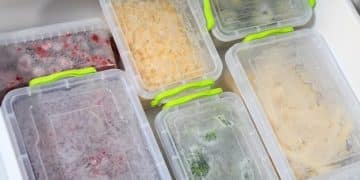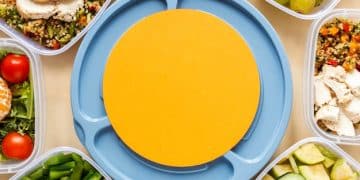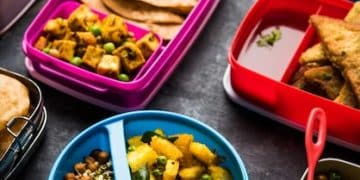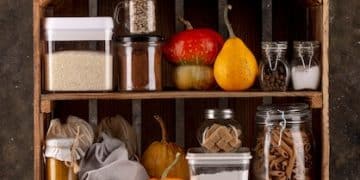Maximize Your Freezer: Expert Meal Planning Tips for Success
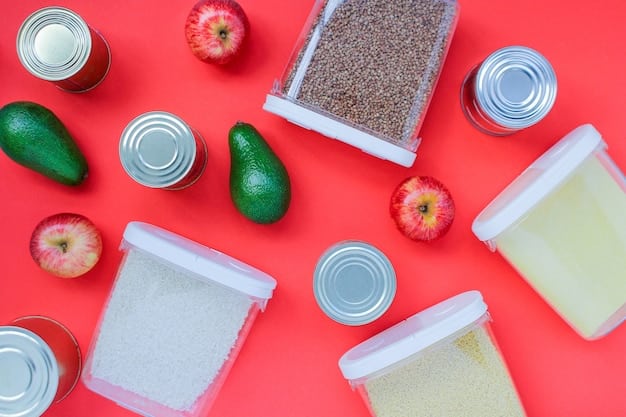
Maximize Your Freezer: Expert Tips for Extended Meal Planning Success provides essential strategies for efficient freezer organization and food preservation, unlocking long-term meal planning advantages and minimizing food waste.
Are you ready to transform your approach to meal planning? The freezer can be your best friend when it comes to saving time and money. This comprehensive guide, Maximize Your Freezer: Expert Tips for Extended Meal Planning Success, will provide you with the knowledge and skills to optimize your freezer, extend the life of your ingredients, and effortlessly create delicious meals.
Understanding the Power of Your Freezer in Meal Planning
The freezer is often overlooked as a simple storage space, but it’s a powerful tool for effective meal planning. By understanding its capabilities and utilizing it correctly, you can cut down on grocery trips, reduce food waste, and always have ingredients on hand for a quick and easy meal.
Why Freezing is Essential for Meal Planning
Freezing helps you extend the shelf life of perishable items, allowing you to buy in bulk when prices are low and store meals for busy weeknights. It’s about more than just preserving food; it’s about preserving your time and budget.
Addressing Common Freezing Misconceptions
Many people believe freezing degrades food quality, but with proper techniques, the nutritional value and taste can be maintained for extended periods. This section debunks myths and provides the science to support the benefits of freezing.
- Freezing preserves nutrients by slowing down microbial growth and enzymatic activity.
- Proper packaging prevents freezer burn, maintaining flavor and texture.
- Thawing food correctly ensures safety and quality.
In conclusion, understanding the power and potential of your freezer allows for more efficient meal planning, saving time and reducing food waste. By debunking myths and understanding best practices, you can unlock a valuable asset in your kitchen.
Essential Freezer Organization Techniques
Organization is key to maximizing your freezer’s potential. A well-organized freezer not only saves space but also makes meal planning easier and more efficient. This section covers practical techniques to keep your freezer tidy and functional.

Implementing the First-In, First-Out (FIFO) System
The FIFO system ensures that you use older items before newer ones, preventing food from expiring unnoticed in the depths of your freezer. Rotate your stock regularly to maintain freshness.
Strategies for Efficient Labeling and Dating
Clear labeling and dating are crucial for identifying the contents and age of frozen items. Use waterproof labels and include as much detail as possible, such as the dish name, date, and any special instructions.
- Use permanent markers for clear and durable labeling.
- Include the date of freezing to track how long items have been stored.
- Organize labels in a consistent manner (e.g., top left corner) for easy identification.
Effective freezer organization relies on FIFO and clear labeling systems to ensure efficient use and prevent food spoilage. By implementing these techniques, you can save time, reduce waste, and confidently manage your frozen inventory.
Selecting the Right Containers and Packaging
Choosing the right containers and packaging materials is essential for preserving the quality of your frozen food. This section explores the best options for protecting your meals from freezer burn and maintaining flavor.
Comparing Freezer-Safe Containers: Plastic vs. Glass
Both plastic and glass containers have their advantages and disadvantages. Freezer-safe plastic is lightweight and durable, while glass is non-porous and can be used in the oven after thawing. Choose based on your specific needs and preferences.
Mastering Vacuum Sealing Techniques
Vacuum sealing removes air from the packaging, preventing freezer burn and extending the shelf life of your food. This is a worthwhile investment if you freeze food regularly.
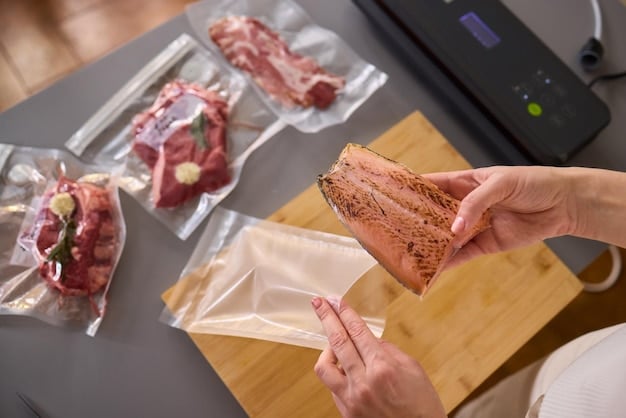
- Vacuum seal meats, vegetables, and pre-made meals to maximize freezer life.
- Use appropriately sized bags to minimize waste.
- Label vacuum-sealed packages clearly with contents and date.
Selecting the right containers and packaging is crucial for preserving the quality and flavor of frozen food. Vacuum sealing is particularly effective for preventing freezer burn and extending shelf life. These strategies ensure that your frozen meals remain delicious and nutritious.
Best Practices for Freezing Different Types of Food
Different foods require different freezing techniques to maintain their quality. This section provides specific guidelines for freezing various food types, ensuring optimal results.
Freezing Fruits and Vegetables: Blanching Tips
Blanching vegetables before freezing deactivates enzymes that can cause discoloration and loss of flavor. Properly prepare fruits to prevent them from becoming mushy.
Freezing Meats and Seafood: Preventing Freezer Burn
Wrap meats and seafood tightly in freezer paper or vacuum seal them to prevent freezer burn. Portion them into meal-sized quantities for convenience.
- Blanch vegetables for the recommended time to preserve color and texture.
- Flash freeze fruits on a tray before transferring them to a freezer bag.
- Vacuum seal meats and seafood to prevent freezer burn and extend shelf life.
Freezing various foods requires specific methods to ensure the best quality and preservation. Blanching vegetables and properly packaging meats and seafood are key to preventing freezer burn and maintaining flavor. Following these guidelines allows you to freeze different types of food effectively.
Creative Meal Planning Ideas Using Frozen Ingredients
Once you’ve mastered freezing, it’s time to put those ingredients to work! This section explores creative meal planning ideas using frozen items, making meal preparation quick and easy.
Quick Weeknight Dinners Using Frozen Staples
Keep frozen vegetables, pre-cooked meats, and grains on hand for easy weeknight dinners. Stir-fries, soups, and casseroles can be prepared in minutes using these staples.
Batch Cooking and Freezing for Future Meals
Batch cooking involves preparing large quantities of meals and freezing them in individual portions. This is a great way to save time and ensure you always have a healthy meal available.
- Create a meal planning calendar to guide your batch cooking efforts.
- Freeze meals in individual portions for easy thawing and serving.
- Label and date all batch-cooked meals for easy identification.
Creative meal planning with frozen ingredients can transform your approach to cooking, saving time and reducing stress. Utilizing frozen staples for quick weeknight dinners and batch cooking for future meals offers convenient and healthy solutions for busy lifestyles.
Thawing Food Safely and Effectively
Safe thawing is just as important as proper freezing. This section provides guidelines for thawing food safely, preserving its quality, and preventing the growth of harmful bacteria.
The Refrigerator Thawing Method
Thawing food in the refrigerator is the safest method, but it requires planning ahead. Allow ample time for the food to thaw completely before cooking.
Using Cold Water for Faster Thawing
If you need to thaw food more quickly, submerge it in cold water, changing the water every 30 minutes to maintain a safe temperature.
- Thaw food in the refrigerator whenever possible for optimal safety.
- Use cold water thawing method for faster thawing, changing the water regularly.
- Never thaw food at room temperature to prevent bacterial growth.
Thawing food safely ensures that it remains nutritious and free from harmful bacteria. Using the refrigerator method is the safest, while the cold water method provides a faster alternative. Proper thawing techniques are crucial for maintaining food safety and quality.
Conclusion
Maximizing your freezer is a game-changer for efficient meal planning. By following these expert tips, you can reduce food waste, save time, and enjoy delicious, home-cooked meals any day of the week. Embrace the power of your freezer and transform your kitchen into a hub of culinary convenience.
| Key Point | Brief Description |
|---|---|
| 🧊 Organization | Use FIFO & labels for efficient stock management. |
| 🛡️ Packaging | Vacuum sealing prevents freezer burn effectively. |
| 🥦 Food Prep | Blanch veggies; portion meats for best results. |
| 🍽️ Safe Thawing | Always thaw in fridge or cold water, never at room temp. |
Frequently Asked Questions
▼
Most foods can be safely stored in the freezer for several months. Meats and poultry can last up to a year, while fruits and vegetables are best used within 8-12 months. Always check for signs of freezer burn, which can affect the taste and texture.
▼
Freezer burn occurs when moisture escapes from the surface of frozen food, causing it to dehydrate and develop tough, discolored spots. To prevent it, ensure food is tightly wrapped in airtight packaging, such as freezer bags or vacuum-sealed containers.
▼
It’s generally not recommended to refreeze food that has been completely thawed, as it can increase the risk of bacterial growth. However, if the food still contains ice crystals, it may be safe to refreeze after cooking it thoroughly.
▼
To maintain the texture of fruits and vegetables, blanch vegetables before freezing and flash freeze fruits on a tray before transferring them to a bag. This helps to preserve their structure and prevents them from becoming overly soft.
▼
For freezing liquids, use freezer-safe containers with airtight lids, leaving some headspace to allow for expansion as the liquid freezes. Alternatively, you can use freezer bags, laying them flat to freeze and save space.
Conclusion
Mastering the art of freezer management is a transformative step towards smarter meal planning. With these expert tips, you’re well-equipped to enhance your culinary efficiency, minimize waste, and enjoy nutritious, readily-available meals whenever you desire. Unlock your freezer’s potential and experience the convenience it brings to your everyday life.
